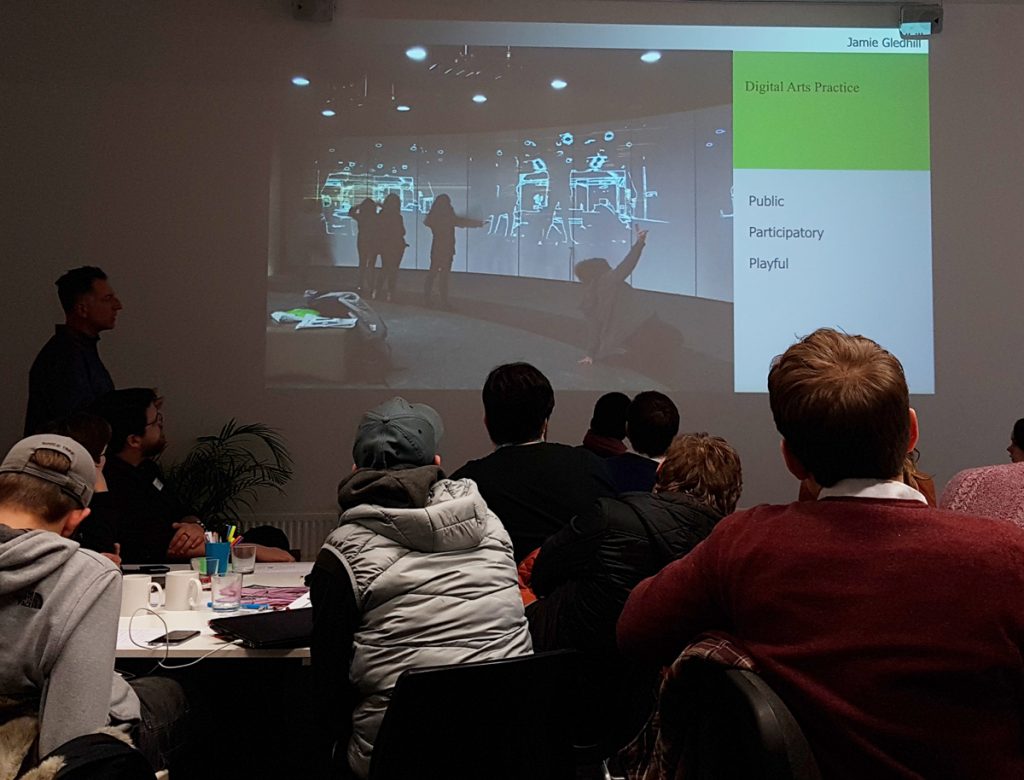Speaking at the recent Plugin Symposium hosted by Signals Media of Colchester, has given me a reason to reflect upon my own creative practice and in particular my urge to investigate the collaborative potential of digital art.
Professional self-reflection is a great activity, particularly when enhanced by the perspective of time: not just a little so that events are still fresh and perhaps too recent to view holistically, but neither too much so that memory is impinged upon by the distance of age! Of course, regular self-reflection is often portrayed as the saviour of creative professionals but ocassional, yet timely, self-reflection is certainly better than none!
Recently, in reflecting upon my own practice, I began by reclaiming the personal manifesto of seeking to create artistic works that are public, participatory and playful – the 3 p’s I set out to explore and draw connections between but a few years ago. I realised that my developing interest in collaborative art can essentially be articulated by a series of questions and corresponding creative responses.
Question: “How do I construct interactive experiences that are a pleasure to interact with and encourage co-interaction?”
Creative Response: Luminescence
Question: “How can I provoke emergent behaviour whereby multiple participants, who may never meet normally, compete or collaborate through the medium of an interactive art work?”
Creative Response: Play Table
Question: “How can I design playful, collaborative interactive experiences that have a positive impact?”
Creative Response: Portals for Mortals
For the sake of a more meaningful presentation at Plugin – I tried to pull together some of the elements that have shown themselves to be of special importance in the process of creating collaborative digital art. So here they are in slightly jumbled form, I hope they may be of some use to you, dear reader…
T is for Technology.
There is a seemingly insatiable appetite for new tech. It’s like a magnet that draws people in… so lets use it to do just that. Like the pathological urge to open Pandora’s Box. As an artist, one must position one’s box of tricks strategically with the metaphorical lid slighty ajar…
P is for the Phenomenon of Play.
Play is a magic circle entirely of our own making. Rules can be made, rules can be broken. Transgressions can be made in perfect safety. The willingness to participate is all it takes…therefore the invitation to play is of particular importance.
F is for Facilitation.
An Artist often plays the role of Facilitator. Collaborative digital art in itself is a facilitation. Some people very much like to be shown what to do – helping them understand how to get involved is an important aspect of facilitation. In certain situations, participants exiting an art experience themselves can become ambassadors to the next group of participants. Facilitation can go viral!
D is for Design.
If Art is about asking questions and opening up possibilities… design in the service of art solves problems and brings the art to life. From tech to user experience, there are many dimensions of design. It is an iterative process and can always be improved – so improve it!
A is for Audience.
Who is the collaborative experience aimed at? If its ‘aimed at everyone’ – that’s a tough call to get right, reword: that’s impossible! By figuring out who collaborative experiences are for, we can make them better, just the same as for any other service or product design – know thy user!
C is for Collaboration.
A truly multi-faceted word. Generally a force for good within the arts. But let’s consider what we mean by it when we use the word. For me it implies creating something new or finding new ways of working together where agency and creativity are bounced around the court of collective imagination. It can be question and response, it can synchronised, multilateral creativity. Whatever form it takes, collaboration can produce amazing results is to be recommended.
R is for Risk
Perhaps a certain amount of risk is inherent in collaboration and maybe that’s why it might feel unsafe and uncertain at times. It won’t work everytime either! One thing is for sure: the best creativity does not occur within a nice padded comfort zone!
